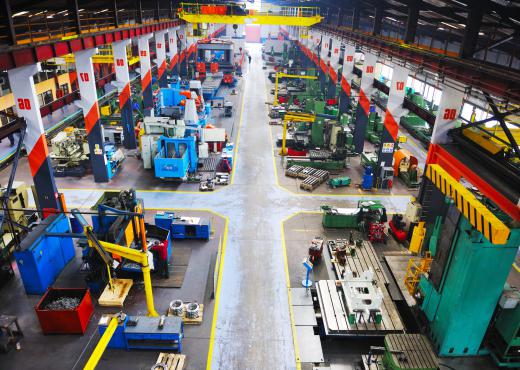Just-in-time manufacturing is a strategy used in the manufacturing industry to reduce costs by reducing the in-process inventory level. It is driven by a series of signals that tell the production line to make the next piece for the product and when it is needed. The signals used are usually simple visual signals, such as the absence or presence of a piece that is needed in the manufacturing process.
In just-in-time manufacturing, reorder levels for certain inventory items are set, and new stock is ordered only when those levels are reached. There is no overstocking of parts or items, which saves on space in the warehouse. This manufacturing strategy can lead to improvements in quality and efficiency. It also can lead to higher profits and a larger return on the company's investment.

Although this specific manufacturing strategy was created by the Toyota company in Japan during the 1970s, previous businesses used manufacturing processes that were based on similar concepts. One of the first was created by Henry Ford, whose automobile company bought materials only for its immediate needs in the manufacturing process. Ford bought only the amount of material that was needed in the plan of production and planned the transportation of materials so that the flow of the product would be smooth. This created a rapid turnover and decreased the amount of money that was tied up in raw materials.

Ford's manufacturing process was adopted by many other car manufacturers. Toyota used the process with satisfactory results and modified it to overcome some of its weaknesses, which led to what is now known as just-in-time manufacturing. The process allowed Toyota to reduce costs and build cars more quickly. Many vehicles were built to order, which reduced the threat that they would be built and not sold, thus eliminating a risk to the company.

Unlike some other types of manufacturing processes, with just-in-time manufacturing, assemblers do not have a choice of which parts to use; every part has to fit correctly. This means that the use of multiple suppliers usually is avoided, and quality assurance is higher. The parts used are all of the same quality, which means that line stops for quality checks are almost eliminated, leading to higher productivity rates. Just-in-time manufacturing principles have been applied to many industries and businesses with successful results.
One potential flaw in just-in-time manufacturing is that it relies on an accurate anticipation of demand. Manufacturers need to gauge the levels of materials and parts that they need based on their previous or current sales figures. If there is a rise or fall in demand for the product, it could have serious effects on the just-in-time manufacturing process. Manufacturers have to make sure that they have a reliable sales forecast in place to allow for these fluctuations in sales, or they could have problems with inventory or with the manufacturing process.
